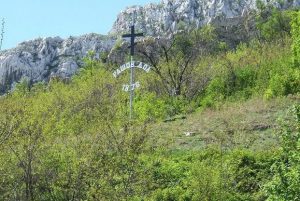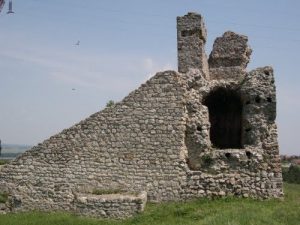

The monastery Osenovlashki “The Holy Virgin”, known under the name of the Seven Thrones, is situated in a picturesque area of the Balkan Mountains, at the skirts of the mountain Izmerets in the beautiful valley of the small river Gabrovnica. In order to arrive at the monastery there is passed the Quays of the River. It must be walked 12 km on an asphalted road at Osenovlak, which leads to the gates of the monastery.
According to the legend, the origin of the monastery is connected with the Bulgarian aristocrat Petar Delian, the leader of the insurrection from 1040 of the Bulgarians against the Byzantium. It isn’t known what the faith of the monastery was in the years in which Bulgaria was conquered by the Turks. There are written proofs concerning the existence of the monastery from the beginning of the XVIth century and in the XVIIth century. The monastery has been destroyed repeatedly and it was extremely serious damaged in 1737, then it was rebuilt by the Bulgarian population in 1770, there followed the other devastating effects and its last re-conditioning was in 1815 when it was also built the today’s monastery church.
Together with the recovery of the monastery in the XVIth century there are held spiritual and literary and educational activities. Starting with this moment it is known a written Gospel used in the monastery. There were also used other liturgical books – the gospel from 1551, the printed edition by Bozidar Vukovic and others. The same religious school was opened in 1849 by the monk Christopher who taught to read and to write many children from the surrounding villages. With these activities, the monastery kept the knowledge of popular vigilance of the Bulgarian enslaved population from the area.
The monastery has been repeatedly a refuge for the revolutionaries in the times of the national freeing movement, including the one of the apostle for the freedom, Vassil Levski. Here also found protection the Valchan lider, the leader Martin, Sofronius of Vratsa and many others. The national poet Ivan Vazov wrote here the ballad “The sound of the bell” – July 1899.
Besides the historical data, it exists a separate legend about the creation of the monastery. According to it, Seven Thrones has been founded by 7 aristocrats (or 7 brothers under an alternate version of the legend), from where it also comes the name of the monastery. It is estimated that the 7 aristocrats come from Basarabia from the 11th century where they have established in the mountains with their families. Their appearance in these countries is also associated with the appearance of seven villages from the proximity of the monastery – Osenovlak, Ogoia, Sofia, Ogradishte, Bukovec, Leskovdol and Lakatnik.
Between the legend and the reality, the Monastery “Seven Thrones” kept even today the artistic spirit of the old masters, in an incredible mixture of archaism with the creative accomplishments of the Bulgarian Renaissance.
As well as most of the Bulgarian monasteries, Seven Thrones is surrounded by a tall stone wall, and the church is situated in the middle of the courtyard. In addition, the complex also includes a bell tower and two residential perpendicular buildings. The bell tower has two bells (which date back to 1799 and 1940) with wooden and metal rattling – the last one was taken in 1799 from the remains of the Roman citadel.
The biggest construction of the monastery was done in the XIXth century. In a renovation from 1868, the church has been combined with an opened narthex, whose white arches bring color to the monastery’s courtyard. On the old foundations, at north from the church of 1877, the local masters built an imposing building with four floors, which in 1849 at the second floor accommodated the principal monk from the monastery’s school, Hristofor. At two superior floors, around the great porches there are also other sanctums for the monks. On the façade of this building with the view towards the courtyard there were painted religious scenes. The second building, above the entrance in the monastery, was built one year later and it was the bed and breakfast of the monastery. Through a layered system, on another picturesque terrace there can be arrived to the spacious rooms. This architectonic building is one of the greatest accomplishments of the buildings of our monasteries. Picturesque scenery which, unfortunately, after the re-conditioning hasn’t been completely recovered, has been added in the monastery’s courtyard.
The “Seven Thrones” monastery is kept until present as a repeatedly re-conditioned church, and as an architectural type it most certainly is situated so far in time, as initiator of a legend. The monastery’s temple in the oldest parts of it constitutes a simplified version, a construction in the shape of a cruciform square and the occupied space is divided in seven parts – a nave in the shape of a cross and six nave chapels which surrounds the chapel were a part of the old church, proof that this plan represented a model for the temple monastery with an architectural style which came from the Balkan Peninsula. In the Xth – XIth century from Caucasus in the Bulgarian lands there were built this kind of churches very rarely, only during the times of the XIth – XIIth century, when around the Byzantium in the Bulgarian architecture they got into the known shapes of Armenians from Georgia.
Redone several time throughout the past century, the monastery Tsyrkva lost completely its authentic architecture, but in the spirit of the medieval interiors float around everywhere arches. The frescos follow the tradition established in the churches, namely of the nave, similar arched. In the center of the arch there is a “Pantocrator Christ” and “the Older Church”. In the eastern part there is found the “Christ in light” – a part of the composition “The Ascension” and in the western region – “The Transfiguration of Jesus” part of the scene. In the apse there is the scene of “Mary and son” and under it “The Adoration of the victim”. On both parts of the apse there are the scenes of the “Baptize”, “The Sacrifice of Avraam” and “In the tomb”. With regards to the composition from the long walls we have the “Celebrations”, “Christ sick”. On the western part above the entrance there is the scene of the “Assumption” and “Saint Constantin and Helen”. The frescos from the church are executed by an unknown artist in the traditions of the late Medieval Bulgarian art – a charming relic, the only one which remained with sculptures in the church’s rood screen and in the chapels, dating back to the XVIIth – XVIIIth century, although put into practice with the archaic technique, which combines the vegetal ornaments with the animal images. Big biblical icons with sculpted frames show styles which came from the hands of the masters from the past, of the late local iconographic tradition, such as Nicolas Priest of the Republic, professor Uros and Stoyu Troyan. All these show the fact that the iconographic path dates back to the XVIIth century – the XVIIIth century, in which there are occupied spaces of the church which are reserved for the general presentation of the artistic visions of the sculpture and painter nasters from the region of the Western Balkans in the XVIIth – the XVIIIth century. Its last appearance, which is the most interesting sculpture work in the monastery, which date back to 1815, and consists of the biggest wooden chandelier “Horo”, formed from fifteen pieces of colored sculpted scenes. Two big icons of the iconostasis “Saint Virgin Hodegetria” and “Christ Pantocrator” from the first half of the XIXth century, most likely being done by the hands of the masters from Tryavna.
“Here there mustn’t lack the fact that here there ends the earthly land in unexplainable circumstances – he wasn’t loved by the power of the Dragon” (Svetozar Dimitriov) – publicist, crater of comprising works. Trogatelen is the inscription from his tomb – words written from the soul of this eminent Bulgarian:
“My soul lingers after silence
My heart beat ceaselessly for peace.
Stara Planina call me proud
And I am in his monastery.”
Today, the monastery is completely re-built, together with its unique architecture, with its well kept garden, with many flowers, shrubs with flowers and old trees by the spirit and the atmosphere which can be felt here, the wonderful nature which surrounds the monastery, and which make this place to be unique and unforgettable.



